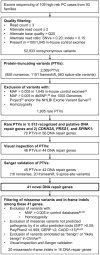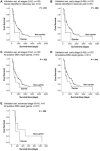Candidate DNA repair susceptibility genes identified by exome sequencing in high-risk pancreatic cancer
- PMID: 26546047
- PMCID: PMC5725760
- DOI: 10.1016/j.canlet.2015.10.030
Candidate DNA repair susceptibility genes identified by exome sequencing in high-risk pancreatic cancer
Abstract
The genetic basis underlying the majority of hereditary pancreatic adenocarcinoma (PC) is unknown. Since DNA repair genes are widely implicated in gastrointestinal malignancies, including PC, we hypothesized that there are novel DNA repair PC susceptibility genes. As germline DNA repair gene mutations may lead to PC subtypes with selective therapeutic responses, we also hypothesized that there is an overall survival (OS) difference in mutation carriers versus non-carriers. We therefore interrogated the germline exomes of 109 high-risk PC cases for rare protein-truncating variants (PTVs) in 513 putative DNA repair genes. We identified PTVs in 41 novel genes among 36 kindred. Additional genetic evidence for causality was obtained for 17 genes, with FAN1, NEK1 and RHNO1 emerging as the strongest candidates. An OS difference was observed for carriers versus non-carriers of PTVs with early stage (≤IIB) disease. This adverse survival trend in carriers with early stage disease was also observed in an independent series of 130 PC cases. We identified candidate DNA repair PC susceptibility genes and suggest that carriers of a germline PTV in a DNA repair gene with early stage disease have worse survival.
Keywords: DNA repair genes; Exome sequencing; Familial pancreatic cancer; Pancreatic adenocarcinoma.
Copyright © 2015 Elsevier Ireland Ltd. All rights reserved.
Conflict of interest statement
Figures






References
-
- Canadian Cancer Society's Advisory Committee on Cancer Statistics. (2015) Canadian Cancer Statistics 2015. Toronto, ON: Canadian Cancer Society; 2015.
-
- Howlader N, Noone A, Krapcho M, et al. SEER Cancer Statistics Review, 1975-2011. Bethesda, MD: National Institutes of Health, National Cancer Institute; 2013. [cited November 2013]. Current version available at: http://seer.cancer.gov/csr/1975_2011.
-
- Al-Sukhni W, Borgida A, Rothenmund H, et al. Screening for pancreatic cancer in a high-risk cohort: an eight-year experience. Journal of Gastrointestinal Surgery. 2012;16:771–783. - PubMed
-
- Langer P, Kann PH, Fendrich V, et al. Five years of prospective screening of high-risk individuals from families with familial pancreatic cancer. Gut. 2009;58:1410–1418. - PubMed
Publication types
MeSH terms
Substances
Grants and funding
LinkOut - more resources
Full Text Sources
Other Literature Sources
Medical
Research Materials
Miscellaneous

